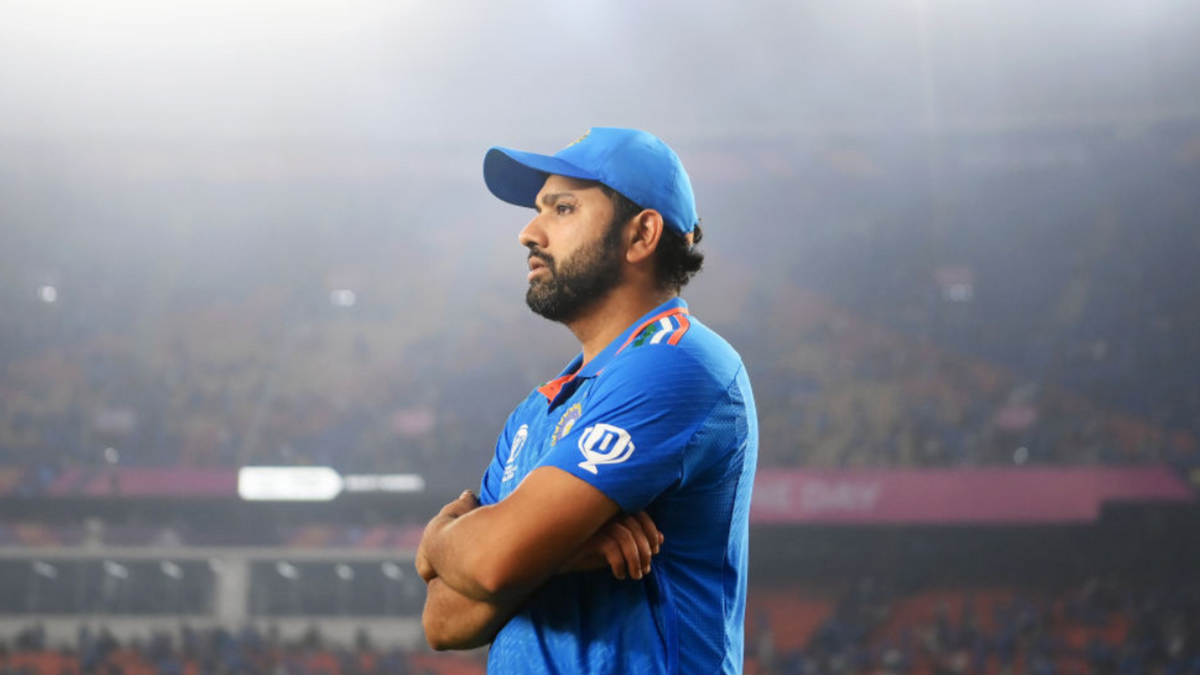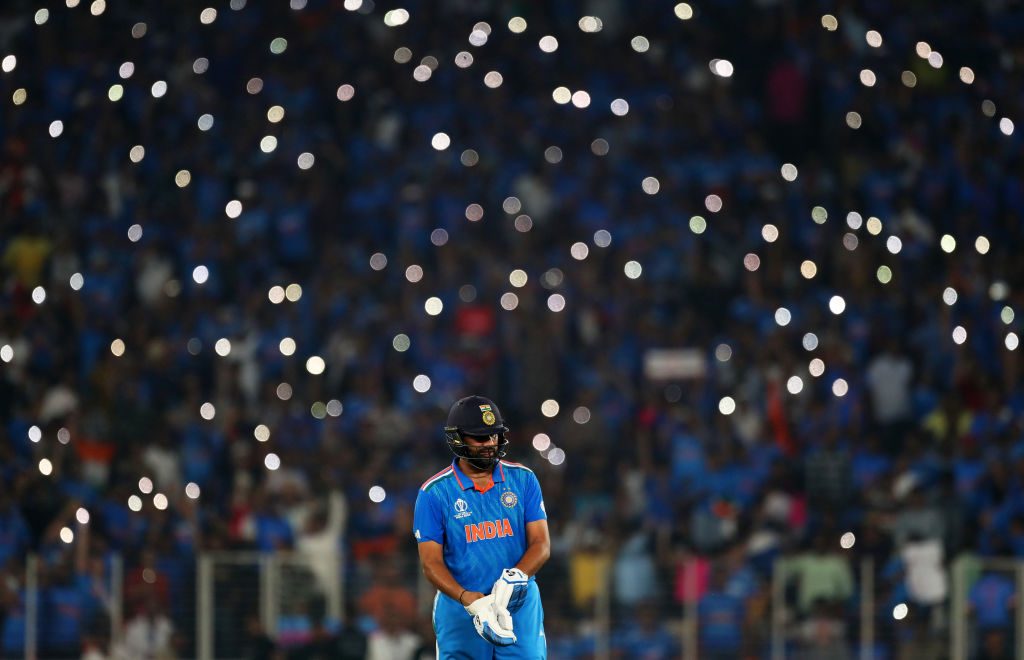
Rohit Sharma killed the run-chase against Pakistan with the bat, but the foundations of the one-sided victory were laid by his smart tactics on the field, writes Naman Agarwal.
To bet on the World Cup with our Match Centre Partners bet365 head here.
A low full-toss on leg stump was glanced calmly to fine leg for a single. That was how Rohit Sharma’s first ball in the run-chase against Pakistan at the 2022 T20 World Cup in Melbourne played out. The two other deliveries he faced in the first over were both half-volleys which he dead-batted. The bowler was Shaheen Afridi.
It was an entirely different spectacle at the Narendra Modi Stadium in Ahmedabad on Saturday, however. Home World Cup. Bigger crowd. Same opponents. Same bowler. This time the first ball of the run-chase was flicked violently over square leg for a boundary.
It was a statement of intent from Rohit. A statement that was promised, but wasn’t made in the T20 World Cup last time. A statement that signaled a change in mindset. After the work of his bowlers, Rohit had almost completely dismissed Pakistan’s already slim chances of staging a comeback in the game just one ball into the run-chase.
He continued on in his new-found butcher-y avatar, taking on one Pakistan bowler after another in his knock of 86 (63). Rohit, the batter, had delivered the killer blow. Yet, despite his vicious pull shots and picturesque inside outs, there was another aspect of his game today that might have been more important, more impactful. His leadership.
[breakout id=”0″][/breakout]
[caption id=”attachment_586930″ align=”alignnone” width=”1024″] Rohit Sharma was at his belligerent best with the bat in Ahmedabad[/caption]
Rohit Sharma was at his belligerent best with the bat in Ahmedabad[/caption]
In games of such magnitude as this one, it is easy to follow pre-defined templates and miss the tempo of the game from a tactical point of view. Rohit, however, was on point with almost every move of his, reading the pulse of the game and the conditions to near-perfection.
It started at the toss. With the kind of batting India have, and the form of their batters, it would have been a tempting decision to bat first, put runs on the board, and let the pressure of the scoreboard (which is real, mind you) dictate the game in the second innings. But India opted to field, with Rohit mentioning at the toss that he didn’t expect the track to change much: “It’s a good track, not going to change much, dew could be a big factor and keeping that in mind, we want to bowl first.”
Eyebrows were raised. People claimed that it was a defensive move that might backfire if Pakistan started well. As a matter of fact, they did start well, and thoughts soon turned to the 2017 Champions Trophy Final. Everyone knows what happened there.
Mohammed Siraj, who had bowled his second-most expensive ODI spell in the last game against Afghanistan, looked out of sorts with the new ball, which is supposed to be his biggest strength. His first three overs went for 22. The pitch wasn’t offering much. “What is he doing?” was the common sentiment among Indian fans watching Siraj bowl. The temptation to replace him would have been high. But Rohit stuck with him for a fourth over, trusting him to adapt to the insipid conditions. Siraj adapted. A rare cross-seam delivery on the last ball of his fourth over skidded through and caught Abdullah Shafique plumb in front to hand India their first break.
[breakout id=”1″][/breakout]
Hardik Pandya was brought on as the first-change seamer ahead of Shardul Thakur, and he delivered as well, picking the wicket of Imam-ul-Haq in his third over. In fact, Thakur ended up bowling only two overs while Pandya bowled six. Comparing the level of threat both of them posed on the Ahmedabad surface, that was a fair division of labour between the two.
Usually, India go to Ravindra Jadeja first as far as bringing on spin is concerned. However, Babar Azam’s struggles against Kuldeep Yadav have been well-documented. Rohit was quick to assess the situation as Kuldeep was brought on as soon as the first powerplay was over. He was equally quick to replace him with Jadeja in the very next over as Mohammad Rizwan had arrived the crease by the time. Rizwan, a prolific sweeper of the ball, would have preferred the slowness of Kuldeep compared to the darts of Jadeja. And the move almost worked immediately.
Rizwan was given out lbw sweeping Jadeja’s second ball of the day. Fortunately for him, the decision was reversed on review as ball tracking showed that the ball would have missed the leg stump by millimetres.
[breakout id=”2″][/breakout]
There were several other bowling changes and field placements that Rohit did to have a massive impact on the game. Siraj was recalled for a second spell in the 28th over when Jadeja and Kuldeep were being milked around with relative ease by the duo of Babar and Rizwan. It resulted in Babar being dismissed for 50. The madness that ensued in the resulting collapse where Pakistan lost eight wickets for 36 runs also had a method behind it.
When Kuldeep got two wickets in the 32nd over, leaving Pakistan at 166-5, Rohit sensed blood and brought back his trump card, Bumrah. It took him six balls to produce a magical off-cutter that ripped through Mohammad Rizwan. Another beauty in his next over cleaned up Shadab Khan. Seven overs and 20 runs later, Pakistan were all out for 191.
It took India just 30.3 overs to chase down the target and extend their lead over Pakistan to 8-0 in men’s ODI World Cups. Rohit hit six sixes in his knock of 86, batting at a strike rate of 136.50. The other day in Delhi, he had hit five with a strike rate of 155.95.
India would be beyond happy with this version of Rohit the batter and the timing of his emergence. In terms of potential impact on the game, he has no competitor except one – Rohit, the captain. Unfortunately for Pakistan, they were up against the best of both today. There’s no winning when that happens.








